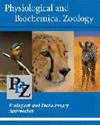Hemolymph Glycemia as an Environmental Stress Biomarker in the Invasive Red Swamp Crayfish (Procambarus clarkii)
IF 1.8
3区 生物学
Q3 PHYSIOLOGY
引用次数: 0
Abstract
Several freshwater crayfish species, including Procambarus clarkii, are both ecologically important and commercially important benthic macroinvertebrates, remarkable for their potential to adapt and reproduce but also for their unique abilities to face distinct abiotic and biotic environments and become successful invaders. While much work has been done to study crayfish introductions, less focus has been given to how crayfish cope with pollution and other environmental stressors, in terms of physiological responses, and whether crayfish responses can be used to assess the effective state of their living environment. Here, we used a mixed approach combining laboratory experiments with field data to validate the use of hemolymph glucose as a relevant biomarker of red swamp crayfish (Procambarus clarkii) stress response. Three meaningful sampling locations were chosen across southern Portugal that are representative of different environments where crayfish live and are frequently captured for human consumption but also correspond to different pollution levels. To reference field measurements of glucose levels, we performed two lab-based experiments: (a) crayfish were exposed to different levels of stress (stress challenge) and (b) crawfish were exposed to a maze dispersal test, with or without water. Crayfish glucose levels were responsive to induced stress but were not correlated with dispersal efforts. Wild crayfish’s body condition and stress levels responded differently to environmental conditions, with more challenged individuals showing higher glycemia levels but similar body condition. The glucose levels of the more stressed wild crayfish were visually similar to lab-based crayfish subjected to the higher stress levels (electric shocks), while the levels of glucose of crayfish at the less polluted site corresponded to those measured before the start of the challenge (baseline). The maintenance of high levels of glycemia in crayfish inhabiting more challenging habitats is revealing of their higher energetic demand state. Since P. clarkii ia globally distributed and easily sampled invasive species, quantifying its hemolymph glucose levels can be a particularly useful proxy for assessing environmental quality.克氏原螯虾(Procambarus clarkii)血淋巴血糖作为入侵红沼泽小龙虾环境应激的生物标志物
包括克氏原螯虾(Procambarus clarkii)在内的几种淡水小龙虾,在生态上和商业上都是重要的底栖大型无脊椎动物,它们不仅具有适应和繁殖的潜力,而且具有面对不同的非生物和生物环境并成为成功入侵者的独特能力。虽然对小龙虾引进的研究已经做了很多,但对小龙虾如何应对污染和其他环境压力的生理反应以及小龙虾的反应是否可以用来评估其生存环境的有效状态的关注较少。本文采用实验室实验与野外数据相结合的混合方法,验证了血淋巴葡萄糖作为红沼泽小龙虾(原螯虾克氏)应激反应的相关生物标志物的有效性。在葡萄牙南部选择了三个有意义的采样地点,这些地点代表了小龙虾生活的不同环境,它们经常被捕获供人类食用,但也对应于不同的污染水平。为了参考葡萄糖水平的现场测量,我们进行了两个基于实验室的实验:(a)小龙虾暴露于不同水平的压力(应激挑战),(b)小龙虾暴露于迷宫分散测试,有水或没有水。小龙虾的葡萄糖水平对诱导应激有反应,但与分散努力无关。野生小龙虾的身体状况和压力水平对环境条件的反应不同,受到更多挑战的个体表现出更高的血糖水平,但身体状况相似。受到更大压力的野生小龙虾的葡萄糖水平在视觉上与受到更高压力(电击)的实验室小龙虾相似,而在污染较少的地方的小龙虾的葡萄糖水平与挑战开始前的测量值(基线)相一致。小龙虾生活在更有挑战性的栖息地,其血糖水平维持在较高水平,表明其能量需求较高。由于克氏假单胞菌是全球分布且易于采样的入侵物种,因此量化其血淋巴葡萄糖水平可作为评估环境质量的特别有用的代理。
本文章由计算机程序翻译,如有差异,请以英文原文为准。
求助全文
约1分钟内获得全文
求助全文
来源期刊
CiteScore
3.20
自引率
6.20%
发文量
62
审稿时长
6-12 weeks
期刊介绍:
Physiological and Biochemical Zoology: Ecological and Evolutionary Approaches primarily publishes original research in animal physiology and biochemistry as considered from behavioral, ecological, and/or evolutionary perspectives. Studies at all levels of biological organization from the molecular to the whole organism are welcome, and work that integrates across levels of organization is particularly encouraged. Studies that focus on behavior or morphology are welcome, so long as they include ties to physiology or biochemistry, in addition to having an ecological or evolutionary context.
Subdisciplines of interest include nutrition and digestion, salt and water balance, epithelial and membrane transport, gas exchange and transport, acid-base balance, temperature adaptation, energetics, structure and function of macromolecules, chemical coordination and signal transduction, nitrogen metabolism and excretion, locomotion and muscle function, biomechanics, circulation, behavioral, comparative and mechanistic endocrinology, sensory physiology, neural coordination, and ecotoxicology ecoimmunology.

 求助内容:
求助内容: 应助结果提醒方式:
应助结果提醒方式:


